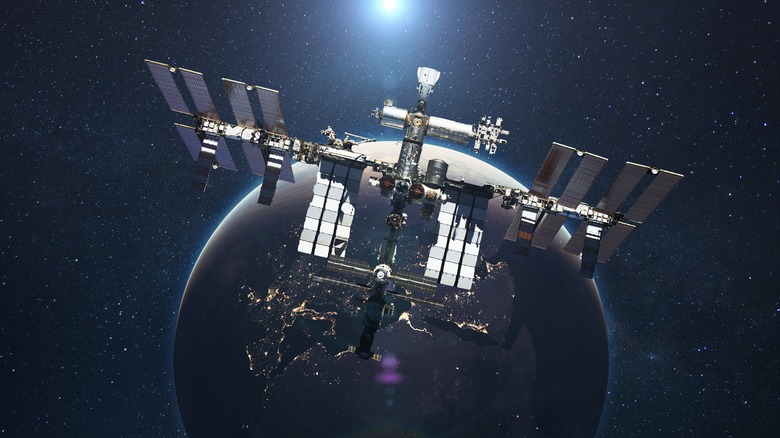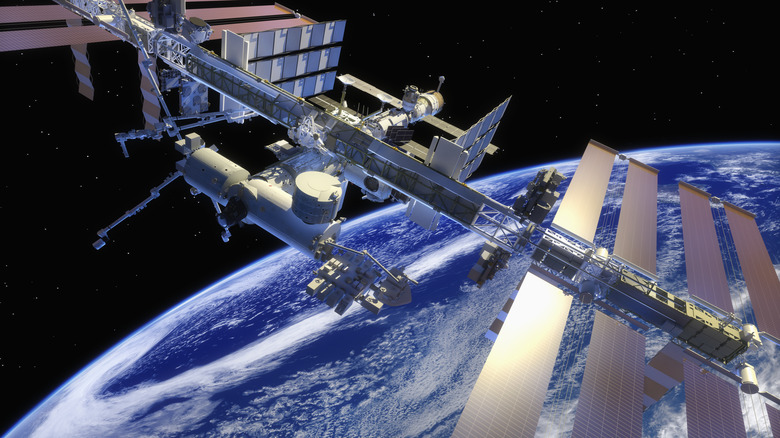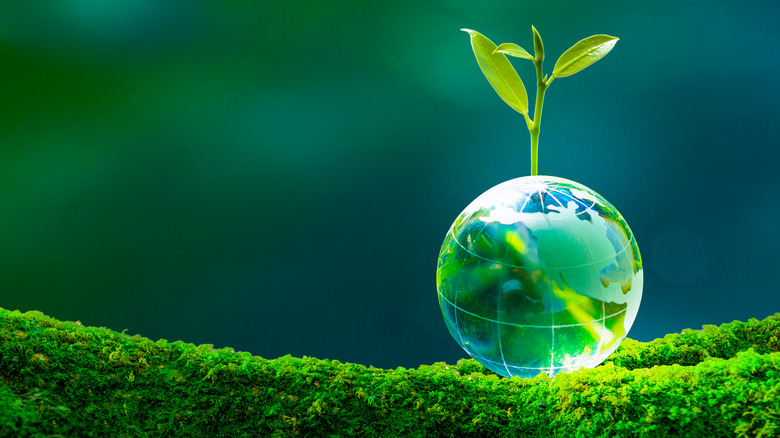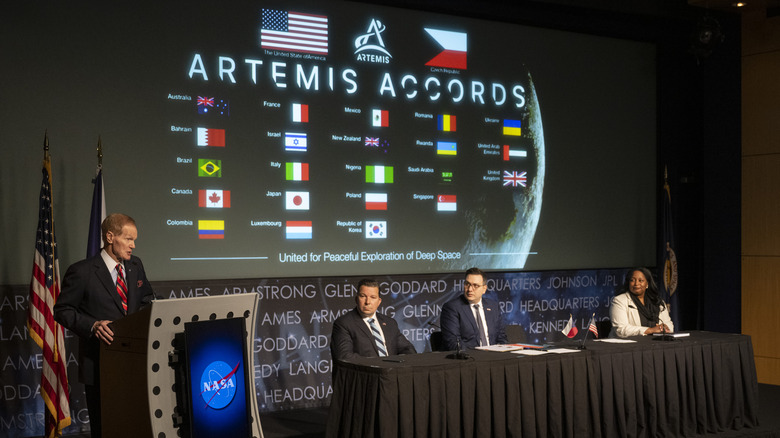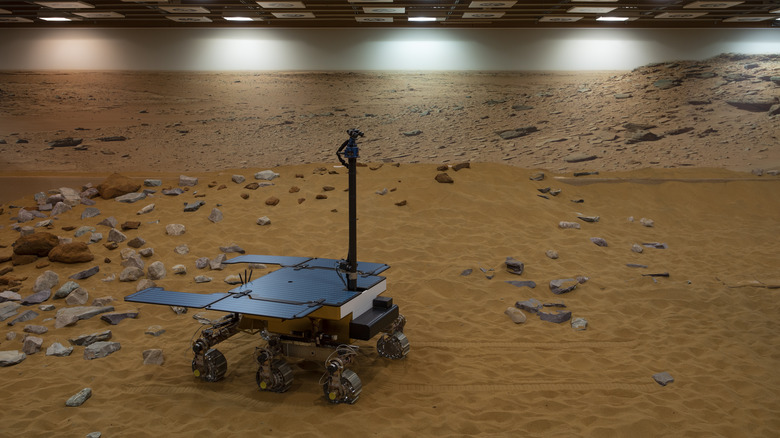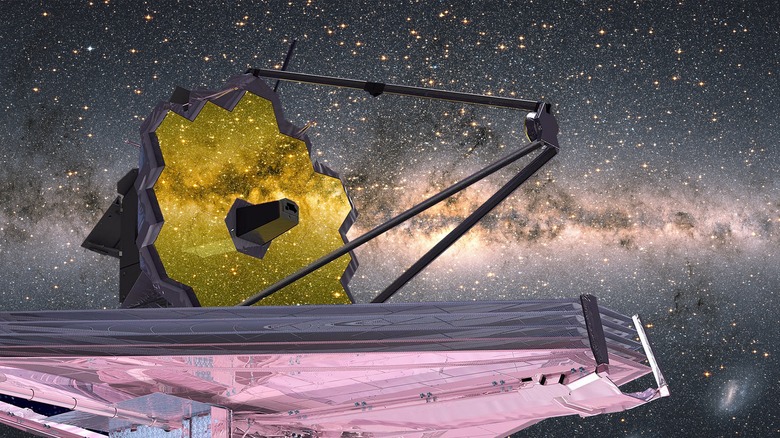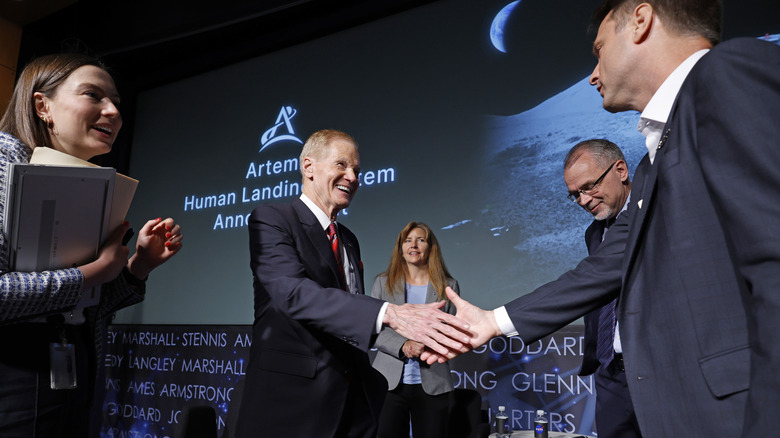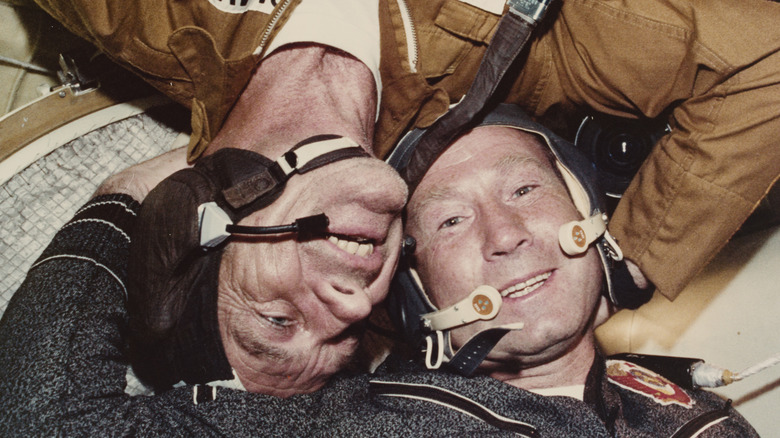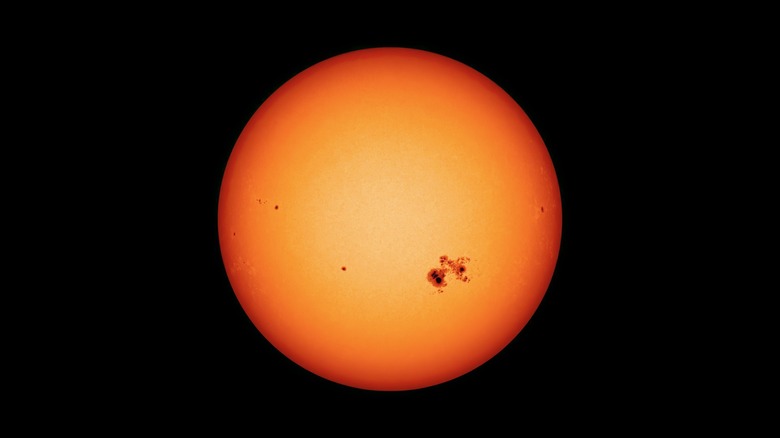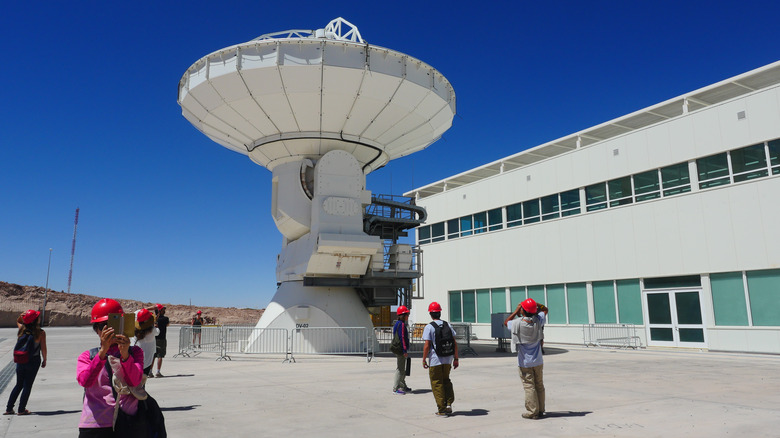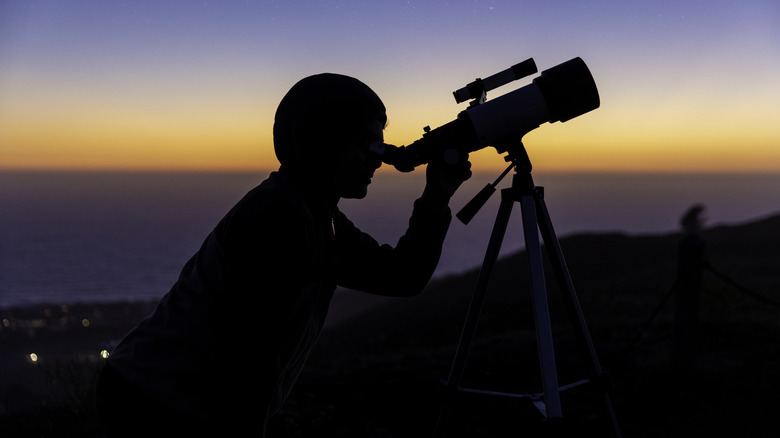10 International Collaborations That Pushed Space Exploration Into The Future
Space is the final frontier. People have spent millennia looking up at the stars and wondering what all might be out there, and it wasn't too long ago we finally managed to send people up there. In the few decades the world has been engaged in space exploration, great strides have already been made. NASA is exploring innovative new technologies not only to push humanity further into the cosmos but to help people carry on in their day-to-day lives here on Earth.
The United States may have landed on the moon and planted an American flag there, but to achieve the most out of it, space exploration is really more of a team effort. Fortunately, NASA and space programs for other countries have been collaborating on plenty of projects to develop new technology and get clearer glimpses of what's really going on beyond our planet.
If we ever find alternate life or otherwise, it's only appropriate that all of mankind share in the glory. Some of these collaborations are already up and running, while others are just launching, but they show what can be accomplished when countries and international companies work together.
International Space Station (ISS)
The International Space Station is the most obvious collaborative space effort. President Ronald Reagan directed the construction of the ISS in 1984, with the first crew to reside on the station in 2000. The mission showed how far the world had come, as Bill Shepherd of NASA and Sergei Krikalev and Yuri Gidzenko of Russia first boarded. The American astronauts and Russian cosmonauts illustrared a world beyond the Cold War.
More organizations around the globe contribute to the ISS, including the Canadian Space Agency, the European Space Agency, and the Japan Aerospace Exploration Agency. Most individuals expect to spend at least a few months on the station, pursuing any essential maintenance and conducting scientific experiments with those who came from an entirely different background. Living on the International Space Station brings it share of challenges, such as getting sufficient sleep, but it's a reminder of how humanity isn't necessarily from a bunch of different countries but instead one single planet.
Many scientific breakthroughs have been made on the ISS, including great strides made in disease research on treating cancer, heart disease, and Parkinson's disease. Scientists also examined how to grow food in zero gravity, which will undoubtedly prove vital if humanity wishes to send humans even further into space.
Collaborative Plant Growth Systems
Astronauts being able to feed themselves during long expeditions is paramount to exploring even deeper space reaches. Only so much food can be stowed before it's depleted or payload capacity is met, so there needs to be a way to make more. There are systems in place on the International Space Station to recycle urine into drinkable water, and growing food in those conditions is in testing. Another international effort has begun to find a way to grow vegetables in the very near future.
The project is a result of several European organizations like the Australia-based ARC Centre of Excellence in Plants for Space and Vertical Future, but there's additional support from NASA and the Australian Space Agency. Many Australian universities are also bringing their expertise to the space station, which is expected to go into orbit in 2026. It will maintain a low orbit from Earth and should require minimal human intervention to create an autonomous agricultural growth system to help feed crews on longer expeditions.
Professor Matthew Gilliham of the University of Adelaide spoke highly of the project, according to Space & Defense, "It will help us to deliver our aims of enabling long-term space habitation, and we will also be able to [utilize] the technology we develop to improve sustainability of food, medicine, and material production on Earth."
Artemis Accords
A bunch of countries all racing to space at once could prove dangerous. A set of guidelines and principles were understandably required to ensure the entire planet benefits from space exploration. In 2020, NASA established the Artemis Accords, which are a set of non-binding principles to aimed at promoting civil engagements in space. There are controversial aspects of the U.S.-led Artemis Accords, including the fact that lunar mining and building may be a possibility, but overall, the goal is to help more people get into space.
NASA helmed the Artemis Accords, with the U.S. agency's' main objective being to put a woman, person of color, and an international partner on the moon. The goal is also to maintain a more consistent presence on the lunar surface, so the world can regularly be reminded of how remarkable it is we've come as a species.
As of September 2024, 43 countries have signed the accords, including Brazil, France, India, and Saudi Arabia, among others. Some countries, like Russia and China, won't to sign the accords, asserting that they favor Euro-centric policies, but ideally, they may help set the stage for humans landing on Mars and beyond.
ExoMars Mission
The ExoMars Mission has gone through various starts and stops over the years. The ultimate goal is to search for signs of life on Mars from a Trace Gas Orbiter that was launched in 2016 and the expected launch of the Rosalind Franklin rover. It's named for the British chemist who made numerous discoveries in the fields of DNA and RNA. The project has been spearheaded by the European Space Agency, and at one point, the organization was supposed to collaborate with United States, but isn't anymore. The ESA then began working with Roscosmos, the Russian space agency, but there have been significant delays in launching the rover.
The Rosalind Franklin rover was supposed to launch in 2018 but hit technical delays. The COVID-19 pandemic caused more delays, and before it could make its launch date in the later part of 2022, the Russian invasion of Ukraine forced the ESA to pull out of the partnership. Anyone asking what will happen to the ExoMars rover now may take solace in hearing that the launch should commence in 2028.
Space exploration is never easy, as these ups and downs show. But the Rosalind Franklin rover could determine any obstacles for humans landing on Mars and better understanding overall habitability.
James Webb Space Telescope
When one thinks of the best images from space, they may have been taken with the James Webb Space Telescope. It's the largest telescope mankind has in space equipped with high-sensitivity instruments that capture objects in stunning detail. The telescope launched in 2021, and it has already made significant contributions to our understanding of the universe.
For starters, the James Webb Space Telescope has uncovered an exoplanet with life-sustaining properties, namely having a hydrogen-rich atmosphere as well as water beneath the surface. It's also uncovered ancient galaxies and supermassive black holes, but it's also produced just as many debates. The telescope has caused scientists to wonder what the true expansion rate of the universe is, and while the data with other tools may not always align with one another, it just gets us closer to the truth.
NASA was the leader in installing the telescope, but it had assistance from the European and Canadian Space Agencies. It's believed the telescope will have enough fuel to last 20 years in orbit, but its lifespan will ultimately depend on any damage it sustains.
Lunar Gateway
A big component of space exploration moving forward is more consistent missions to the Moon. As part of the aforementioned Artemis Accords, this includes the development of a lunar gateway that will enable longer-term human-led missions to the surface. The goal is to build a habitable space station on the Moon, allowing people to stay in space longer, as well as research stations to conduct important analysis while in space.
It's a collaborative effort, as NASA leads the project with aid from Europe, Canada, Japan, and the United Arab Emirates. The goal is to start with the Artemis IV lunar mission, scheduled for 2028. Part of the Artemis IV mission, in addition to ensuring the gateway is viable, will be to send a team to visit the Moon's surface. This could very well be when the world sees the first woman touch down on the moon's surface and make history.
Artemis IV is scheduled to be followed by Artemis V and VI, which should also see manned missions to the Moon. Only 12 individuals have walked on the Moon in humanity's existence, but that club could soon get a lot bigger.
Apollo-Soyuz Test Project
It's certainly fun to look toward the future of international collaboration in space, but it's vital to remember its roots too. The first ever international partnership to venture into space was the Apollo-Soyuz Test Project in 1975. The Cold War was far from over, but the United States had effectively won the space race by being the first country to get to the Moon. At this point, the project could be seen as the two nations trying to move forward into a bolder political future with five crew members going on the spaceflight — three Americans and two cosmonauts from the Soviet Union.
The Apollo-Soyuz Test Project also served some scientific functionality — the goal was to test docking systems and see if different modules could be compatible in the event that a rescue mission became necessary. The crewmembers only spent two days together but conducted various experiments during that time.
It's easy to take international space collaborations for granted in the era of the International Space Station, but it was a big deal for the two countries to come together at this time. A lifelong friendship was also forged during this, as Thomas P. Stafford and Alexei Leonov. Their initial handshake all those years ago remains incredibly symbolic, and Stafford made Leonov the godfather to two of his children. And when Leonov passed away in 2019, Stafford delivered a eulogy in Russian.
Solar Orbiter
Many prospective space missions focus on the Moon, likely since humans can actually walk on the surface. But it's also crucial for us to better understand the Sun. In that endeavor, the European Space Agency, with aid from NASA, launched the Solar Orbiter in 2020. In the short time the orbiter has been active, it's made incredible progress in sending scientists some of the clearest images of the Sun ever taken.
The ESA's Solar Orbiter has numerous objectives, including determining the origin of the corona's magnetic field and learning more about how solar transients impact the Sun's heliosphere. Arguably, the most significant thing the orbiter will accomplish is taking pictures of the Sun's northern and southern poles. Images of these areas had never been taken before, and looking at the poles is truly remarkable now. For instance, scientists can see how the poles allow gases to escape into space, leading to solar wind.
The project is expected to last until at least 2027, but the orbiter could easily continue providing valuable data into the 2030s. The fact there's a device equipped to handle the Sun's intense heat is impressive enough already.
Atacama Large Millimeter/submillimeter Array
Space partnerships don't always have to involve launching craft among the stars. There's still much humanity can learn about space from Earth, which is why many countries have come together to support the Atacama Large Millimeter/submillimeter Array (ALMA), located in northern Chile. It's an ideal location for observing the galaxy due to its high elevation and low humidity. The billion-dollar project has been a fruitful partnership among the United States, Chile, Canada, Europe, South Korea, Japan, and Taiwan.
It's the most complex astronomical structure on Earth and has already provided many fascinating insights into space. ALMA is responsible for detecting the most ancient magnetic field scientists have seen in a far-off galaxy. Understanding magnetic fields is crucial to the formation of galaxies, and in a statement, Rob Ivison, an astronomer for the European Southern Observatory, said the discovery could reveal "a new window onto the inner workings of galaxies, because the magnetic fields are linked to the material that is forming new stars."
ALMA has also given researchers valuable images of black holes and protoplanetary disks. Plus, ALMA is open for tours for anyone with an appreciation of all things space.
Several Education and Outreach Programs
Stephanie Wilson is among many female astronauts being considered for the Artemis mission to put the first woman on the Moon. When speaking with Space.com, she discussed the future of space collaboration, "There are many opportunities now for women in STEM [science, technology, engineering and math], so I encourage these young girls to study hard," she explained. "If math and science is their interest then they can certainly find their way to NASA for a career." Those interested in pursuing space study as a career should know many universities, such as Harvard and the California Institute of Technology, have plenty of opportunities for those around the globe to advance their knowledge.
Most notably, the International Space University, which has been around since 1987, provides training and education to those who wish to study the final frontier. The primary campus is in France, but there are additional hubs in the United States and the Asia Pacific region. The university is home to numerous alumni, including Jessica Meir, who received a Master of Science in Space Studies from there. She'd go on to be flight engineer for multiple expeditions on the International Space Station.
Other international efforts include the Space Generation Advisory Council and the International Astronomical Union. SGAC is a non-profit organization dedicated to representing the interests of younger generations to ensure their thoughts and concerns are address in new space policies. IAU exists that helps promote and protect the interest of space study. Numerous divisions still plague the world, but it can be uplifting to see various countries set aside their differences to help one another learn more about where we all came from.
